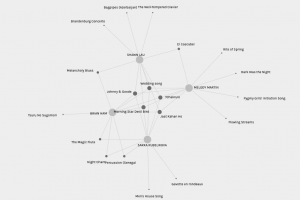I was part of Group 2 in the data set, consisting of myself, Shawn Lau, Melody Martin and Sarka Kubelikova. Here is a screenshot of our connected network:

The next image shows the 5 songs that all members of my group shared.

List:
Johnny B. Goode
Morning Star/Devil Bird
Wedding Song
Jaat Kahan Ho
Tchakarulo
As I examined this list, I found it difficult to ascertain if there were any qualities in the 5 chosen pieces that tied them all together. At first glance, a simple reading of the data could be looked at as coincidental. You can see that there are 5 pieces of music that the 4 of us all chose to include in our individual Golden Record assignments, and it could be possible that there is no deeper meaning to the grouping at all.
I was most interested in comparing my groups choices to those of the entire class, so I decided to take a look at the overall popularity of all tracks amongst the entire class.

Here are the top 10 most popular 10 tracks overall, with the number of class members who chose the track in parentheses:
Jaat Kahan Ho (19)
Morning Star/Devil Bird (16)
Johnny B. Goode (15)
Fifth Symphony (15)
El Cascabel (14)
Wedding Song (12)
Percussion-Senegal (12)
Tchakrulo (12)
Flowing Streams (12)
Melancholy Blues (12)
It is interesting to look at the list of top 10 overall tracks from all participants, and compare that to my own group. I noticed that the 5 common connections among my own group are all in the top 10 choices of the entire class, specifically the 1st, 2nd, 3rd, 6th and 8th choice.
One commonality between my groups choices and the top choices of all participants is the lack of “classical” music, which I will use as a simple catch all term to describe orchestral music in the western european tradition. During the original curation exercise, I felt that there was overabundance of classical music on the Golden Record, which I found a bit puzzling considering that it was supposed to be a balanced representation of the music that earth has to offer. However, one has to also look at not only who was making the choices for the record, , but the era in which the choices were made. The Golden Record was created in the 1970’s and the curators were mostly middle-aged caucasian men. These people most likely had a particular idea in their head of what “good” music was, and what would they would consider to be beautiful or high quality. I think that this helps to explain that bias towards classical music at the time, and I feel that this bias would not be as pronounced if the record was being curated today. Of course, if it was being curated now, perhaps there would have been other genres included such as rap/hip hop and electronic music.
Another common thread between my groups choices and the top 10 overall is the diversity in both the style & sound of the tracks, as well as the cultures where the tracks originated. I think some of this can be ascribed to who we are as students. We are all Canadian, and study at a Canadian institution, yet we all come from a wide variety of cultural backgrounds. Being in a masters program, I can safely assume that we are all highly educated people, which would make us generally more aware and sensitive to cultural diversity and inclusion. I believe this mindset allows us as a class to be more open-minded when doing an exercise such as this, and to have a much broader definition of what “beautiful” or “quality” music would be versus someone who may be less educated.
Yes, I agree. The exercise is amusing but not revealing, showing correlation but not causation. So, I don’t know that you learn anything. I put stuff into voyanttools.com which was also amusing.